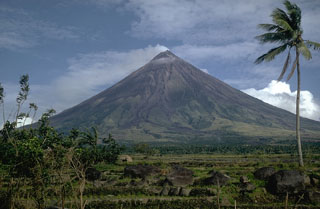Report on Mayon (Philippines) — 5 June-11 June 2013
Smithsonian Institution / US Geological Survey
Weekly Volcanic Activity Report, 5 June-11 June 2013
Managing Editor: Sally Sennert.
Please cite this report as:
Global Volcanism Program, 2013. Report on Mayon (Philippines) (Sennert, S, ed.). Weekly Volcanic Activity Report, 5 June-11 June 2013. Smithsonian Institution and US Geological Survey.
Mayon
Philippines
13.257°N, 123.685°E; summit elev. 2462 m
All times are local (unless otherwise noted)
PHIVOLCS reported that during 5-10 June white to off-white steam plumes that drifted WSW, NW, WNW, NNE, and NE, and occasional bluish fumes, were observed at Mayon. Incandescence emanated from the crater during most evenings into early mornings; cloud cover prevented crater observations during 7-8 and 10-11 June. During 5-6 and 9-10 June the seismic network recorded one volcanic earthquake each period, and during 6-7 June one rockfall signal was detected. The Alert Level remained at 1; PHIVOLCS reminded the public not to enter the 6-km-radius Permanent Danger Zone (PDZ).
Geological Summary. Symmetrical Mayon, which rises above the Albay Gulf NW of Legazpi City, is the most active volcano of the Philippines. The steep upper slopes are capped by a small summit crater. Recorded eruptions since 1616 CE range from Strombolian to basaltic Plinian, with cyclical activity beginning with basaltic eruptions, followed by longer periods of andesitic lava flows. Eruptions occur predominately from the central conduit and have also produced lava flows that travel far down the flanks. Pyroclastic density currents and mudflows have commonly swept down many of the approximately 40 ravines that radiate from the summit and have often damaged populated lowland areas. A violent eruption in 1814 killed more than 1,200 people and devastated several towns.
Source: Philippine Institute of Volcanology and Seismology (PHIVOLCS)

